Nursing Reflection on NSQHS Standards 4 and 5
VerifiedAdded on 2023/06/07
|6
|1450
|313
AI Summary
This nursing reflection paper discusses the experience of caring for a patient with asthma and hypertension, and how it helped in developing skills related to NSQHS standards 4 and 5. The paper highlights the importance of medication safety and patient identification in nursing practice.
Contribute Materials
Your contribution can guide someone’s learning journey. Share your
documents today.
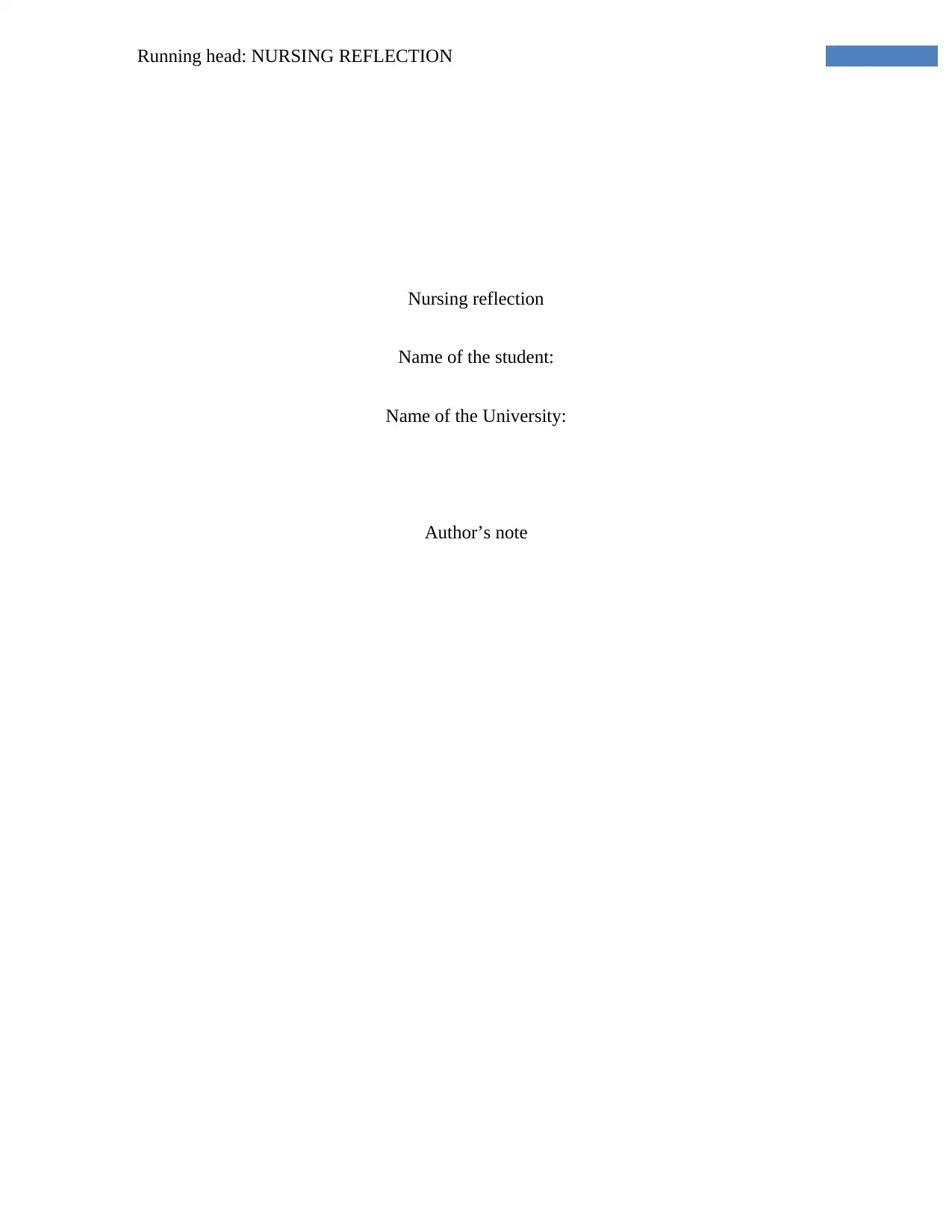
Running head: NURSING REFLECTION
Nursing reflection
Name of the student:
Name of the University:
Author’s note
Nursing reflection
Name of the student:
Name of the University:
Author’s note
Secure Best Marks with AI Grader
Need help grading? Try our AI Grader for instant feedback on your assignments.
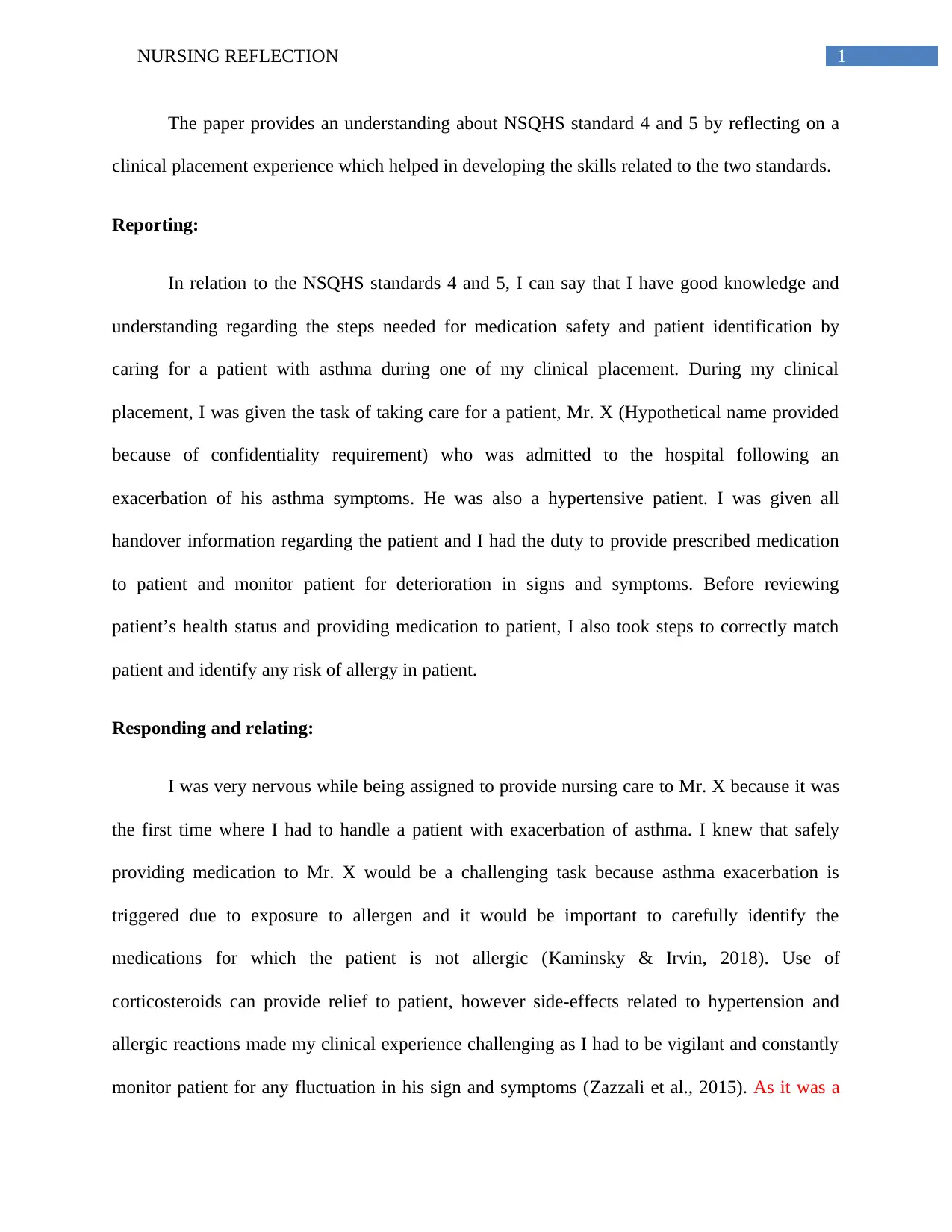
1NURSING REFLECTION
The paper provides an understanding about NSQHS standard 4 and 5 by reflecting on a
clinical placement experience which helped in developing the skills related to the two standards.
Reporting:
In relation to the NSQHS standards 4 and 5, I can say that I have good knowledge and
understanding regarding the steps needed for medication safety and patient identification by
caring for a patient with asthma during one of my clinical placement. During my clinical
placement, I was given the task of taking care for a patient, Mr. X (Hypothetical name provided
because of confidentiality requirement) who was admitted to the hospital following an
exacerbation of his asthma symptoms. He was also a hypertensive patient. I was given all
handover information regarding the patient and I had the duty to provide prescribed medication
to patient and monitor patient for deterioration in signs and symptoms. Before reviewing
patient’s health status and providing medication to patient, I also took steps to correctly match
patient and identify any risk of allergy in patient.
Responding and relating:
I was very nervous while being assigned to provide nursing care to Mr. X because it was
the first time where I had to handle a patient with exacerbation of asthma. I knew that safely
providing medication to Mr. X would be a challenging task because asthma exacerbation is
triggered due to exposure to allergen and it would be important to carefully identify the
medications for which the patient is not allergic (Kaminsky & Irvin, 2018). Use of
corticosteroids can provide relief to patient, however side-effects related to hypertension and
allergic reactions made my clinical experience challenging as I had to be vigilant and constantly
monitor patient for any fluctuation in his sign and symptoms (Zazzali et al., 2015). As it was a
The paper provides an understanding about NSQHS standard 4 and 5 by reflecting on a
clinical placement experience which helped in developing the skills related to the two standards.
Reporting:
In relation to the NSQHS standards 4 and 5, I can say that I have good knowledge and
understanding regarding the steps needed for medication safety and patient identification by
caring for a patient with asthma during one of my clinical placement. During my clinical
placement, I was given the task of taking care for a patient, Mr. X (Hypothetical name provided
because of confidentiality requirement) who was admitted to the hospital following an
exacerbation of his asthma symptoms. He was also a hypertensive patient. I was given all
handover information regarding the patient and I had the duty to provide prescribed medication
to patient and monitor patient for deterioration in signs and symptoms. Before reviewing
patient’s health status and providing medication to patient, I also took steps to correctly match
patient and identify any risk of allergy in patient.
Responding and relating:
I was very nervous while being assigned to provide nursing care to Mr. X because it was
the first time where I had to handle a patient with exacerbation of asthma. I knew that safely
providing medication to Mr. X would be a challenging task because asthma exacerbation is
triggered due to exposure to allergen and it would be important to carefully identify the
medications for which the patient is not allergic (Kaminsky & Irvin, 2018). Use of
corticosteroids can provide relief to patient, however side-effects related to hypertension and
allergic reactions made my clinical experience challenging as I had to be vigilant and constantly
monitor patient for any fluctuation in his sign and symptoms (Zazzali et al., 2015). As it was a
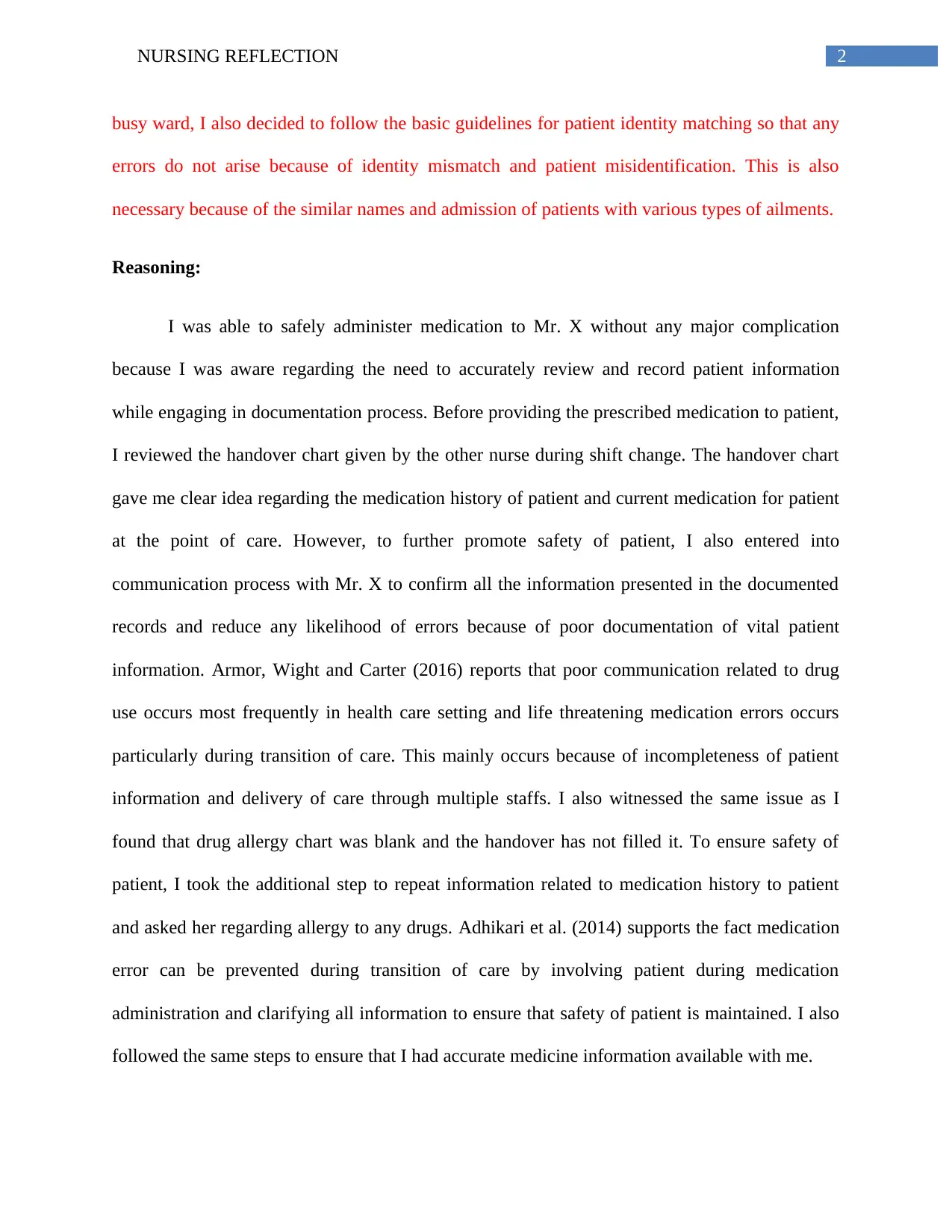
2NURSING REFLECTION
busy ward, I also decided to follow the basic guidelines for patient identity matching so that any
errors do not arise because of identity mismatch and patient misidentification. This is also
necessary because of the similar names and admission of patients with various types of ailments.
Reasoning:
I was able to safely administer medication to Mr. X without any major complication
because I was aware regarding the need to accurately review and record patient information
while engaging in documentation process. Before providing the prescribed medication to patient,
I reviewed the handover chart given by the other nurse during shift change. The handover chart
gave me clear idea regarding the medication history of patient and current medication for patient
at the point of care. However, to further promote safety of patient, I also entered into
communication process with Mr. X to confirm all the information presented in the documented
records and reduce any likelihood of errors because of poor documentation of vital patient
information. Armor, Wight and Carter (2016) reports that poor communication related to drug
use occurs most frequently in health care setting and life threatening medication errors occurs
particularly during transition of care. This mainly occurs because of incompleteness of patient
information and delivery of care through multiple staffs. I also witnessed the same issue as I
found that drug allergy chart was blank and the handover has not filled it. To ensure safety of
patient, I took the additional step to repeat information related to medication history to patient
and asked her regarding allergy to any drugs. Adhikari et al. (2014) supports the fact medication
error can be prevented during transition of care by involving patient during medication
administration and clarifying all information to ensure that safety of patient is maintained. I also
followed the same steps to ensure that I had accurate medicine information available with me.
busy ward, I also decided to follow the basic guidelines for patient identity matching so that any
errors do not arise because of identity mismatch and patient misidentification. This is also
necessary because of the similar names and admission of patients with various types of ailments.
Reasoning:
I was able to safely administer medication to Mr. X without any major complication
because I was aware regarding the need to accurately review and record patient information
while engaging in documentation process. Before providing the prescribed medication to patient,
I reviewed the handover chart given by the other nurse during shift change. The handover chart
gave me clear idea regarding the medication history of patient and current medication for patient
at the point of care. However, to further promote safety of patient, I also entered into
communication process with Mr. X to confirm all the information presented in the documented
records and reduce any likelihood of errors because of poor documentation of vital patient
information. Armor, Wight and Carter (2016) reports that poor communication related to drug
use occurs most frequently in health care setting and life threatening medication errors occurs
particularly during transition of care. This mainly occurs because of incompleteness of patient
information and delivery of care through multiple staffs. I also witnessed the same issue as I
found that drug allergy chart was blank and the handover has not filled it. To ensure safety of
patient, I took the additional step to repeat information related to medication history to patient
and asked her regarding allergy to any drugs. Adhikari et al. (2014) supports the fact medication
error can be prevented during transition of care by involving patient during medication
administration and clarifying all information to ensure that safety of patient is maintained. I also
followed the same steps to ensure that I had accurate medicine information available with me.
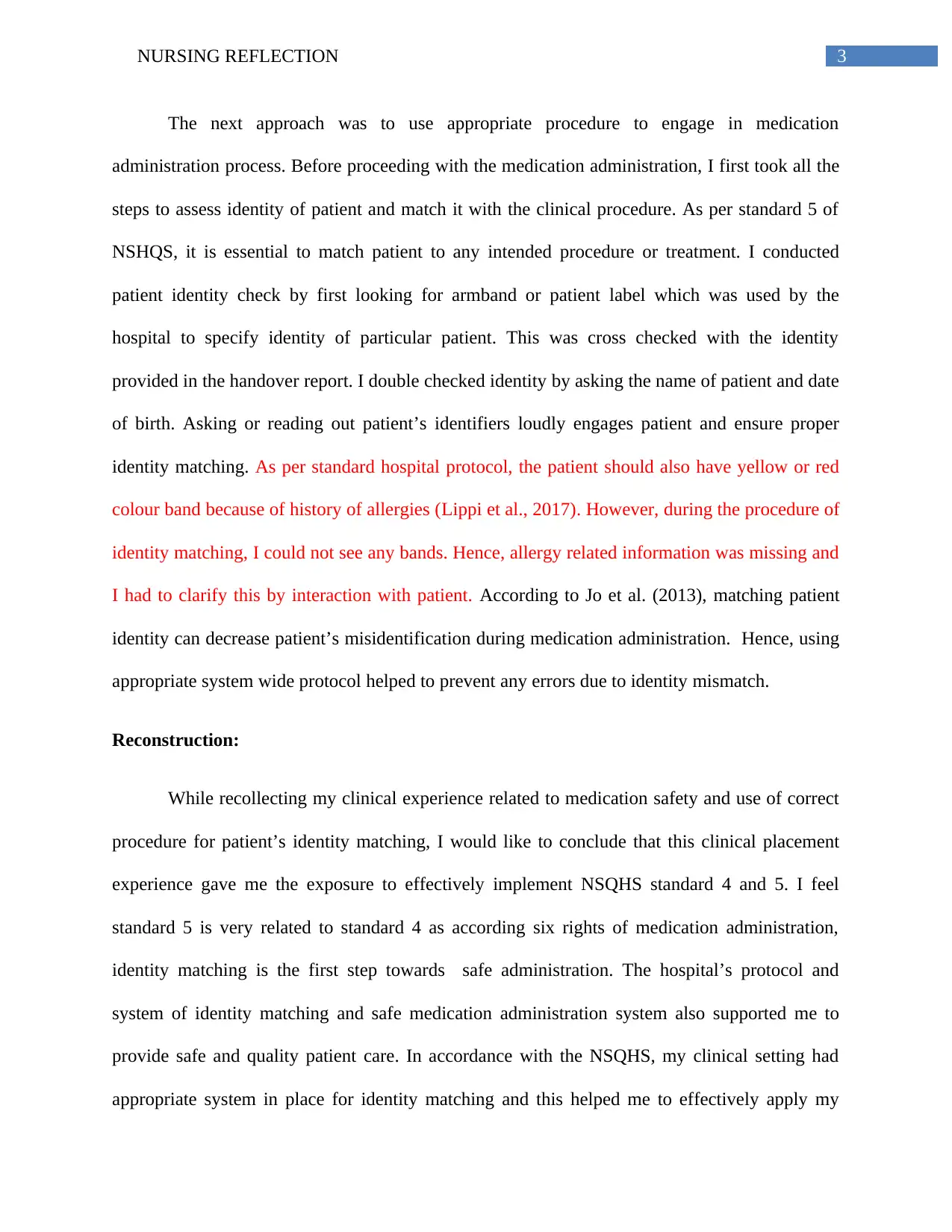
3NURSING REFLECTION
The next approach was to use appropriate procedure to engage in medication
administration process. Before proceeding with the medication administration, I first took all the
steps to assess identity of patient and match it with the clinical procedure. As per standard 5 of
NSHQS, it is essential to match patient to any intended procedure or treatment. I conducted
patient identity check by first looking for armband or patient label which was used by the
hospital to specify identity of particular patient. This was cross checked with the identity
provided in the handover report. I double checked identity by asking the name of patient and date
of birth. Asking or reading out patient’s identifiers loudly engages patient and ensure proper
identity matching. As per standard hospital protocol, the patient should also have yellow or red
colour band because of history of allergies (Lippi et al., 2017). However, during the procedure of
identity matching, I could not see any bands. Hence, allergy related information was missing and
I had to clarify this by interaction with patient. According to Jo et al. (2013), matching patient
identity can decrease patient’s misidentification during medication administration. Hence, using
appropriate system wide protocol helped to prevent any errors due to identity mismatch.
Reconstruction:
While recollecting my clinical experience related to medication safety and use of correct
procedure for patient’s identity matching, I would like to conclude that this clinical placement
experience gave me the exposure to effectively implement NSQHS standard 4 and 5. I feel
standard 5 is very related to standard 4 as according six rights of medication administration,
identity matching is the first step towards safe administration. The hospital’s protocol and
system of identity matching and safe medication administration system also supported me to
provide safe and quality patient care. In accordance with the NSQHS, my clinical setting had
appropriate system in place for identity matching and this helped me to effectively apply my
The next approach was to use appropriate procedure to engage in medication
administration process. Before proceeding with the medication administration, I first took all the
steps to assess identity of patient and match it with the clinical procedure. As per standard 5 of
NSHQS, it is essential to match patient to any intended procedure or treatment. I conducted
patient identity check by first looking for armband or patient label which was used by the
hospital to specify identity of particular patient. This was cross checked with the identity
provided in the handover report. I double checked identity by asking the name of patient and date
of birth. Asking or reading out patient’s identifiers loudly engages patient and ensure proper
identity matching. As per standard hospital protocol, the patient should also have yellow or red
colour band because of history of allergies (Lippi et al., 2017). However, during the procedure of
identity matching, I could not see any bands. Hence, allergy related information was missing and
I had to clarify this by interaction with patient. According to Jo et al. (2013), matching patient
identity can decrease patient’s misidentification during medication administration. Hence, using
appropriate system wide protocol helped to prevent any errors due to identity mismatch.
Reconstruction:
While recollecting my clinical experience related to medication safety and use of correct
procedure for patient’s identity matching, I would like to conclude that this clinical placement
experience gave me the exposure to effectively implement NSQHS standard 4 and 5. I feel
standard 5 is very related to standard 4 as according six rights of medication administration,
identity matching is the first step towards safe administration. The hospital’s protocol and
system of identity matching and safe medication administration system also supported me to
provide safe and quality patient care. In accordance with the NSQHS, my clinical setting had
appropriate system in place for identity matching and this helped me to effectively apply my
Secure Best Marks with AI Grader
Need help grading? Try our AI Grader for instant feedback on your assignments.
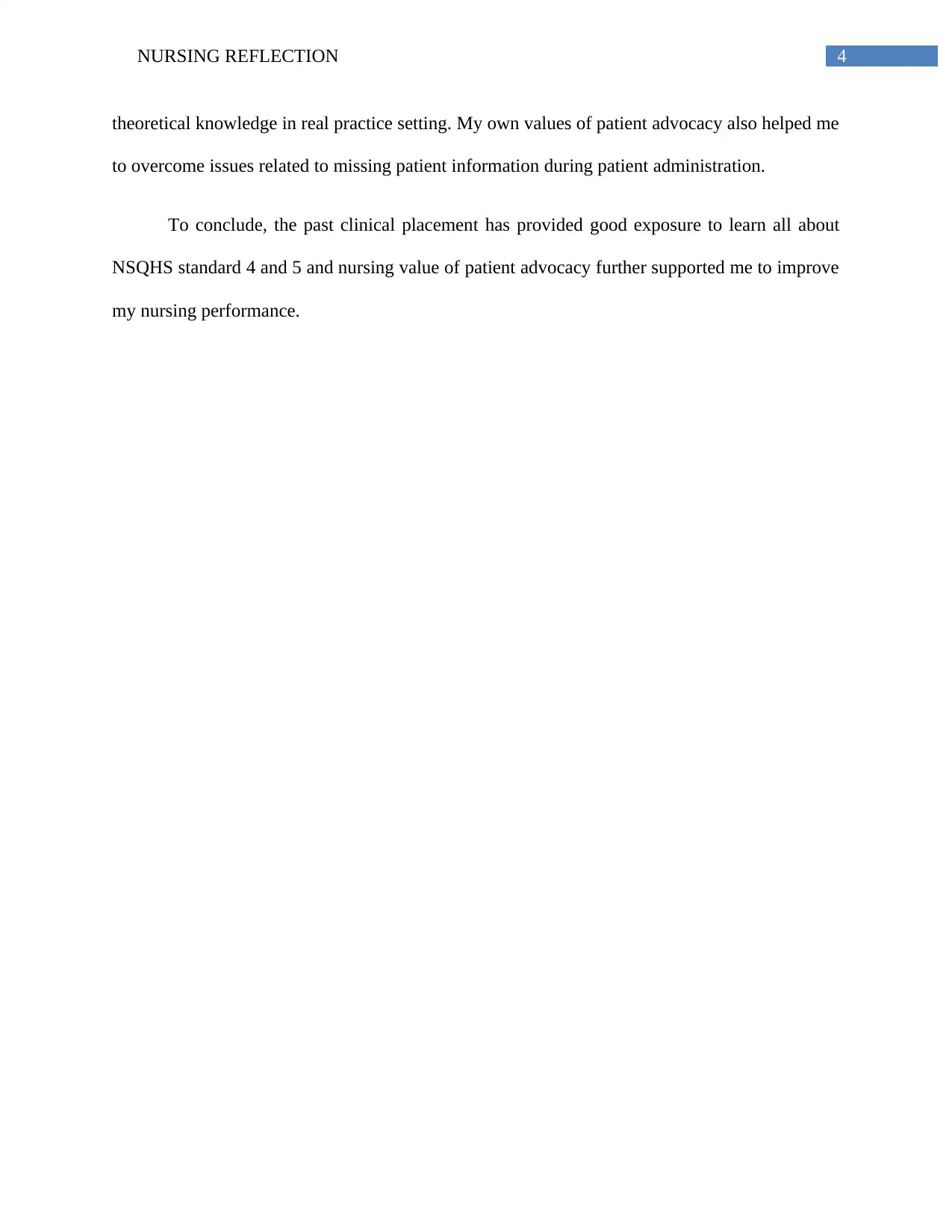
4NURSING REFLECTION
theoretical knowledge in real practice setting. My own values of patient advocacy also helped me
to overcome issues related to missing patient information during patient administration.
To conclude, the past clinical placement has provided good exposure to learn all about
NSQHS standard 4 and 5 and nursing value of patient advocacy further supported me to improve
my nursing performance.
theoretical knowledge in real practice setting. My own values of patient advocacy also helped me
to overcome issues related to missing patient information during patient administration.
To conclude, the past clinical placement has provided good exposure to learn all about
NSQHS standard 4 and 5 and nursing value of patient advocacy further supported me to improve
my nursing performance.
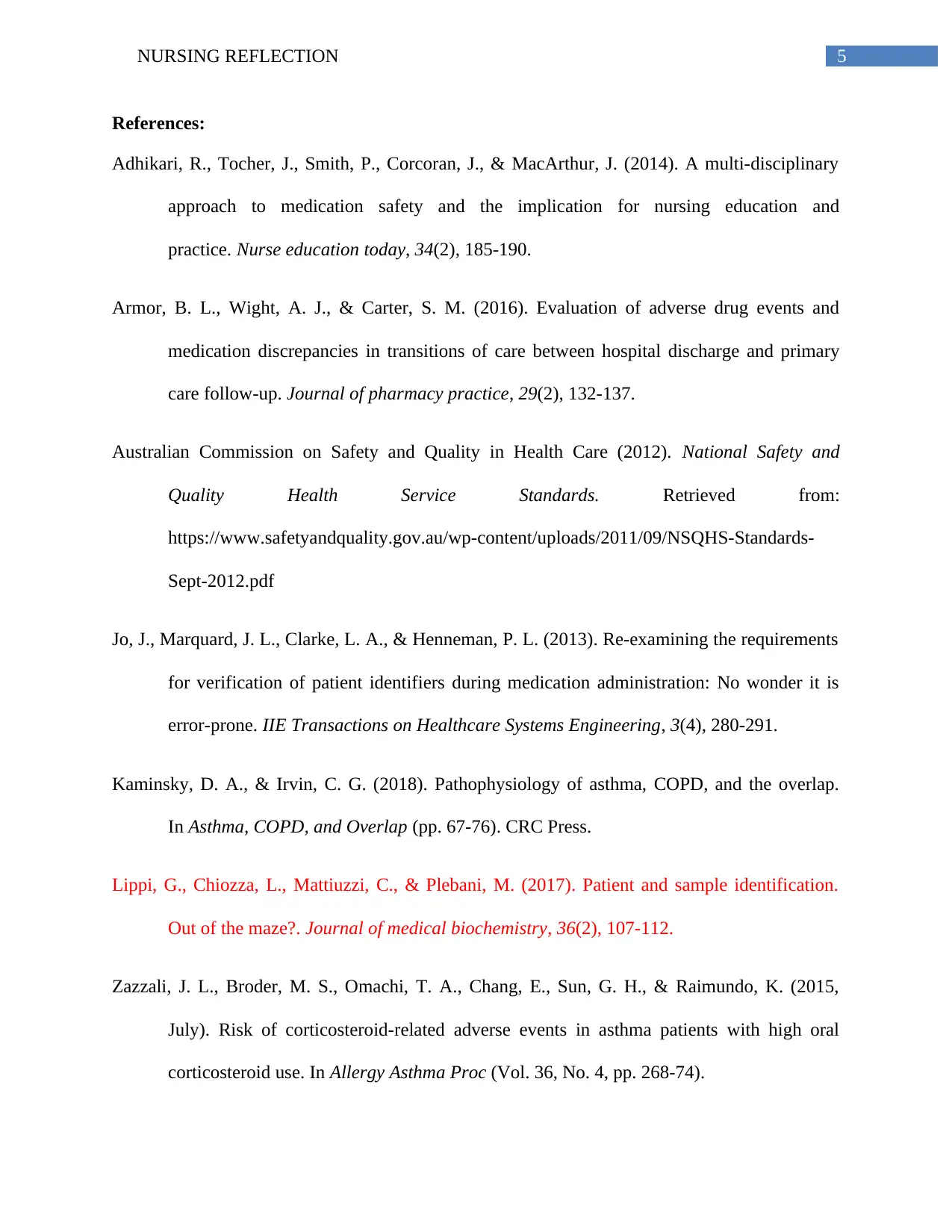
5NURSING REFLECTION
References:
Adhikari, R., Tocher, J., Smith, P., Corcoran, J., & MacArthur, J. (2014). A multi-disciplinary
approach to medication safety and the implication for nursing education and
practice. Nurse education today, 34(2), 185-190.
Armor, B. L., Wight, A. J., & Carter, S. M. (2016). Evaluation of adverse drug events and
medication discrepancies in transitions of care between hospital discharge and primary
care follow-up. Journal of pharmacy practice, 29(2), 132-137.
Australian Commission on Safety and Quality in Health Care (2012). National Safety and
Quality Health Service Standards. Retrieved from:
https://www.safetyandquality.gov.au/wp-content/uploads/2011/09/NSQHS-Standards-
Sept-2012.pdf
Jo, J., Marquard, J. L., Clarke, L. A., & Henneman, P. L. (2013). Re-examining the requirements
for verification of patient identifiers during medication administration: No wonder it is
error-prone. IIE Transactions on Healthcare Systems Engineering, 3(4), 280-291.
Kaminsky, D. A., & Irvin, C. G. (2018). Pathophysiology of asthma, COPD, and the overlap.
In Asthma, COPD, and Overlap (pp. 67-76). CRC Press.
Lippi, G., Chiozza, L., Mattiuzzi, C., & Plebani, M. (2017). Patient and sample identification.
Out of the maze?. Journal of medical biochemistry, 36(2), 107-112.
Zazzali, J. L., Broder, M. S., Omachi, T. A., Chang, E., Sun, G. H., & Raimundo, K. (2015,
July). Risk of corticosteroid-related adverse events in asthma patients with high oral
corticosteroid use. In Allergy Asthma Proc (Vol. 36, No. 4, pp. 268-74).
References:
Adhikari, R., Tocher, J., Smith, P., Corcoran, J., & MacArthur, J. (2014). A multi-disciplinary
approach to medication safety and the implication for nursing education and
practice. Nurse education today, 34(2), 185-190.
Armor, B. L., Wight, A. J., & Carter, S. M. (2016). Evaluation of adverse drug events and
medication discrepancies in transitions of care between hospital discharge and primary
care follow-up. Journal of pharmacy practice, 29(2), 132-137.
Australian Commission on Safety and Quality in Health Care (2012). National Safety and
Quality Health Service Standards. Retrieved from:
https://www.safetyandquality.gov.au/wp-content/uploads/2011/09/NSQHS-Standards-
Sept-2012.pdf
Jo, J., Marquard, J. L., Clarke, L. A., & Henneman, P. L. (2013). Re-examining the requirements
for verification of patient identifiers during medication administration: No wonder it is
error-prone. IIE Transactions on Healthcare Systems Engineering, 3(4), 280-291.
Kaminsky, D. A., & Irvin, C. G. (2018). Pathophysiology of asthma, COPD, and the overlap.
In Asthma, COPD, and Overlap (pp. 67-76). CRC Press.
Lippi, G., Chiozza, L., Mattiuzzi, C., & Plebani, M. (2017). Patient and sample identification.
Out of the maze?. Journal of medical biochemistry, 36(2), 107-112.
Zazzali, J. L., Broder, M. S., Omachi, T. A., Chang, E., Sun, G. H., & Raimundo, K. (2015,
July). Risk of corticosteroid-related adverse events in asthma patients with high oral
corticosteroid use. In Allergy Asthma Proc (Vol. 36, No. 4, pp. 268-74).
1 out of 6
Related Documents
Your All-in-One AI-Powered Toolkit for Academic Success.
+13062052269
info@desklib.com
Available 24*7 on WhatsApp / Email
![[object Object]](/_next/static/media/star-bottom.7253800d.svg)
Unlock your academic potential
© 2024 | Zucol Services PVT LTD | All rights reserved.





